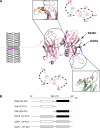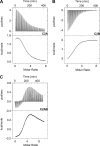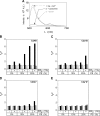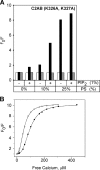The Ca2+ affinity of synaptotagmin 1 is markedly increased by a specific interaction of its C2B domain with phosphatidylinositol 4,5-bisphosphate
- PMID: 19632983
- PMCID: PMC2757977
- DOI: 10.1074/jbc.M109.042499
The Ca2+ affinity of synaptotagmin 1 is markedly increased by a specific interaction of its C2B domain with phosphatidylinositol 4,5-bisphosphate
Abstract
The synaptic vesicle protein synaptotagmin 1 is thought to convey the calcium signal onto the core secretory machinery. Its cytosolic portion mainly consists of two C2 domains, which upon calcium binding are enabled to bind to acidic lipid bilayers. Despite major advances in recent years, it is still debated how synaptotagmin controls the process of neurotransmitter release. In particular, there is disagreement with respect to its calcium binding properties and lipid preferences. To investigate how the presence of membranes influences the calcium affinity of synaptotagmin, we have now measured these properties under equilibrium conditions using isothermal titration calorimetry and fluorescence resonance energy transfer. Our data demonstrate that the acidic phospholipid phosphatidylinositol 4,5-bisphosphate (PI(4,5)P2), but not phosphatidylserine, markedly increases the calcium sensitivity of synaptotagmin. PI(4,5)P2 binding is confined to the C2B domain but is not affected significantly by mutations of a lysine-rich patch. Together, our findings lend support to the view that synaptotagmin functions by binding in a trans configuration whereby the C2A domain binds to the synaptic vesicle and the C2B binds to the PI(4,5)P2-enriched plasma membrane.
Figures







Similar articles
-
Phosphatidylinositol 4,5-bisphosphate increases Ca2+ affinity of synaptotagmin-1 by 40-fold.J Biol Chem. 2012 May 11;287(20):16447-53. doi: 10.1074/jbc.M112.343418. Epub 2012 Mar 23. J Biol Chem. 2012. PMID: 22447935 Free PMC article.
-
Structural insights into the Ca2+ and PI(4,5)P2 binding modes of the C2 domains of rabphilin 3A and synaptotagmin 1.Proc Natl Acad Sci U S A. 2013 Dec 17;110(51):20503-8. doi: 10.1073/pnas.1316179110. Epub 2013 Dec 3. Proc Natl Acad Sci U S A. 2013. PMID: 24302762 Free PMC article.
-
Differential but convergent functions of Ca2+ binding to synaptotagmin-1 C2 domains mediate neurotransmitter release.Proc Natl Acad Sci U S A. 2009 Sep 22;106(38):16469-74. doi: 10.1073/pnas.0908798106. Epub 2009 Sep 4. Proc Natl Acad Sci U S A. 2009. PMID: 19805322 Free PMC article.
-
Exceptionally tight membrane-binding may explain the key role of the synaptotagmin-7 C2A domain in asynchronous neurotransmitter release.Proc Natl Acad Sci U S A. 2017 Oct 3;114(40):E8518-E8527. doi: 10.1073/pnas.1710708114. Epub 2017 Sep 18. Proc Natl Acad Sci U S A. 2017. PMID: 28923929 Free PMC article.
-
Phosphatidylinositol 4,5 Bisphosphate Controls the cis and trans Interactions of Synaptotagmin 1.Biophys J. 2019 Jul 23;117(2):247-257. doi: 10.1016/j.bpj.2019.06.016. Epub 2019 Jun 22. Biophys J. 2019. PMID: 31301806 Free PMC article.
Cited by
-
Synaptotagmin 1 modulates lipid acyl chain order in lipid bilayers by demixing phosphatidylserine.J Biol Chem. 2011 Jul 15;286(28):25291-300. doi: 10.1074/jbc.M111.258848. Epub 2011 May 24. J Biol Chem. 2011. PMID: 21610074 Free PMC article.
-
Alternate splicing of dysferlin C2A confers Ca²⁺-dependent and Ca²⁺-independent binding for membrane repair.Structure. 2014 Jan 7;22(1):104-15. doi: 10.1016/j.str.2013.10.001. Epub 2013 Nov 14. Structure. 2014. PMID: 24239457 Free PMC article.
-
Minimal presynaptic protein machinery governing diverse kinetics of calcium-evoked neurotransmitter release.Nat Commun. 2024 Dec 30;15(1):10741. doi: 10.1038/s41467-024-54960-1. Nat Commun. 2024. PMID: 39738049 Free PMC article.
-
The WNKs: atypical protein kinases with pleiotropic actions.Physiol Rev. 2011 Jan;91(1):177-219. doi: 10.1152/physrev.00017.2010. Physiol Rev. 2011. PMID: 21248166 Free PMC article. Review.
-
The primed SNARE-complexin-synaptotagmin complex for neuronal exocytosis.Nature. 2017 Aug 24;548(7668):420-425. doi: 10.1038/nature23484. Epub 2017 Aug 16. Nature. 2017. PMID: 28813412 Free PMC article.
References
-
- Sudhof T. C. (2004) Annu. Rev. Neurosci. 27, 509–547 - PubMed
-
- Jahn R., Scheller R. H. (2006) Nat. Rev. Mol. Cell Biol. 7, 631–643 - PubMed
-
- Rizo J., Chen X., Araç D. (2006) Trends Cell Biol. 16, 339–350 - PubMed
-
- Wojcik S. M., Brose N. (2007) Neuron 55, 11–24 - PubMed
-
- Chapman E. R. (2008) Annu. Rev. Biochem. 77, 615–641 - PubMed
MeSH terms
Substances
LinkOut - more resources
Full Text Sources
Research Materials
Miscellaneous

